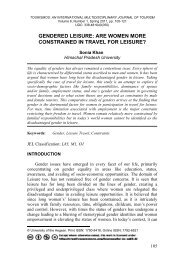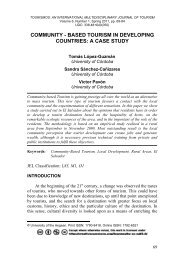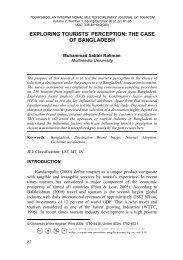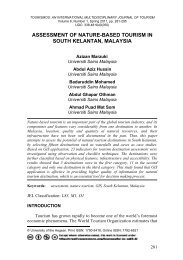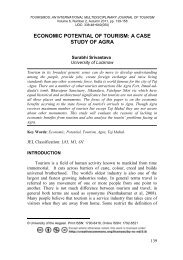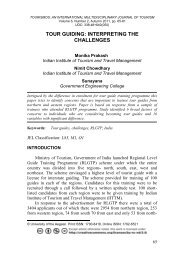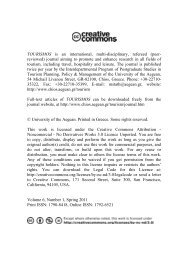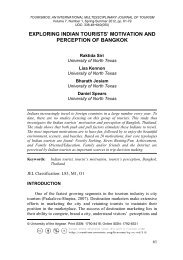is 'malaysia truly asia'? forecasting tourism demand from asean ...
is 'malaysia truly asia'? forecasting tourism demand from asean ...
is 'malaysia truly asia'? forecasting tourism demand from asean ...
Create successful ePaper yourself
Turn your PDF publications into a flip-book with our unique Google optimized e-Paper software.
TOURISMOS: AN INTERNATIONAL MULTIDISCIPLINARY JOURNAL OF TOURISMVolume 7, Number 1, Spring-Summer 2012, pp. 367-381UDC: 338.48+640(050)implemented <strong>forecasting</strong> model and Box-Jenkins approach. Bothapproaches used in th<strong>is</strong> study have its own strength, where the forecastedvalues indicate expected value of the predictor of a future time seriesvalue. Botti et al. (2007) also used a simple econometric model to studythe <strong>demand</strong> for tour<strong>is</strong>m in France, and concluded that tour<strong>is</strong>m <strong>demand</strong> inFrance <strong>is</strong> dependent on available income and relative prices.Unlike most of the tour<strong>is</strong>m <strong>forecasting</strong> studies d<strong>is</strong>cussed earlier,<strong>forecasting</strong> expo <strong>demand</strong> involves both qualitative technique andquantitative <strong>forecasting</strong> models (Lee, Song & Mjelde, 2008). The mainreason to use both techniques <strong>is</strong> because of the limitation of dataavailability. Combining quantitative technique with willingness-to-v<strong>is</strong>it(WTV) surveys, the number of v<strong>is</strong>itors expected to v<strong>is</strong>it internationaltour<strong>is</strong>m expo to be held in Korea in 2012 <strong>is</strong> predicted. Preez and Witt(2003) compared two types of methods to analyze tour<strong>is</strong>m <strong>forecasting</strong>. Intheir study, univariate and multivariate modelling were used separately toforecast tour<strong>is</strong>m <strong>demand</strong> <strong>from</strong> four European countries to Seychelles. Thefindings of the study revealed that the univariate <strong>forecasting</strong> modelsoutperform compare to multivariate models. The empirical result showsthat ARIMA estimation exhibits better <strong>forecasting</strong> performance thanunivariate and multivariate state space modelling. According to Kim andWong (2006), the volatility in tour<strong>is</strong>m <strong>demand</strong> data can be influenced bythe effects of new shocks such as economic cr<strong>is</strong>es, natural d<strong>is</strong>aster or war.In tour<strong>is</strong>m literature, modelling the volatility in tour<strong>is</strong>m <strong>demand</strong> <strong>is</strong>important because it can capture the occurrence of unexpected events.Volatility of tour<strong>is</strong>m <strong>demand</strong> <strong>is</strong> modelled using conditional volatilitymodels, and the models that appears in tour<strong>is</strong>m literature are univariategeneralized autoregressive conditional heterokedasticity (GARCH),univariate asymmetric GARCH, vector autoregressive moving averageGARCH (VARMA-GARCH); and VARMA asymmetry GARCH(VARMA-AGARCH) models (Chan, Lim & McAleer (2005); Kim &Wong (2006); Shareef & McAleer (2005); Shareef & McAleer (2007).In middle of 1990s, dynamic specification such as vector autoregressivemodel (VAR), error correction model (ECM) andautoregressive d<strong>is</strong>tributed lag model (ADLM) began to appear in thetour<strong>is</strong>m literature. VAR model <strong>is</strong> able to accommodate various types ofindependent variables to determine tour<strong>is</strong>t arrivals and <strong>from</strong> there we areable to forecast future tour<strong>is</strong>t arrivals. Besides that, VAR model enablesinnovative use of impulse response analys<strong>is</strong> in tour<strong>is</strong>m context, besidesproviding results on co-integrating analys<strong>is</strong> and <strong>forecasting</strong>. Song andWitt (2004) used VAR model to forecast international tour<strong>is</strong>t flows toMacau for the period <strong>from</strong> 2003 to 2008. The forecast generated by VAR371



